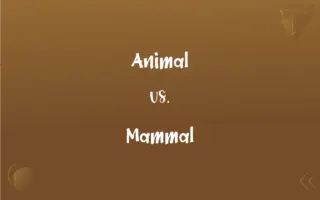Brontosaurus vs. Diplodocus: What's the Difference?
Edited by Aimie Carlson || By Janet White || Published on December 5, 2023
Brontosaurus was bulkier with a longer, more massive neck and shorter tail, while Diplodocus had a slender body, very long tail, and neck.

Key Differences
The Brontosaurus, known for its large, robust body structure, had a significantly heftier and more massive neck compared to the Diplodocus. In contrast, the Diplodocus was characterized by its slender, elongated form, with a less robust neck. Both dinosaurs, however, shared a similar sauropod shape, with four sturdy legs and long necks and tails.
The tail of the Brontosaurus was relatively shorter and thicker, providing balance to its heavy front. On the other hand, the Diplodocus boasted an extremely long and whip-like tail, which was a distinctive feature of this species. This difference in tail structure reflects the varying adaptations and behaviors of these two prehistoric creatures.
Both Brontosaurus and Diplodocus were herbivores, but their feeding habits differed slightly due to their physical differences. The Brontosaurus, with its robust neck, likely fed on tougher vegetation, while the Diplodocus, possessing a more flexible neck, possibly grazed on a wider variety of plants, including those at higher elevations.
Fossil evidence of the Brontosaurus and Diplodocus has been found in different locations, primarily in North America. The discovery of Brontosaurus fossils was significant in the late 19th century, causing a sensation in the scientific community. Similarly, the discovery of Diplodocus fossils contributed greatly to our understanding of sauropod diversity and paleobiology.
Comparison Chart
Body Shape
Bulkier, heavier
Slender, elongated
ADVERTISEMENT
Neck Length
Longer, more massive
Less robust, flexible
Tail Structure
Shorter, thicker
Extremely long, whip-like
Feeding Habits
Tougher vegetation
Variety of plants, high and low
Paleontological Significance
Sensational 19th-century discovery
Enhanced understanding of sauropods
Brontosaurus and Diplodocus Definitions
Brontosaurus
Brontosaurus, a massive dinosaur, once roamed the earth.
The museum's centerpiece was a Brontosaurus skeleton.
ADVERTISEMENT
Diplodocus
Diplodocus had a unique, whip-like tail.
The Diplodocus may have used its tail for defense.
Brontosaurus
Brontosaurus is an iconic figure in paleontology.
Children are often fascinated by the size and strength of the Brontosaurus.
Diplodocus
Diplodocus was known for its extremely long neck.
The Diplodocus could reach higher vegetation thanks to its neck.
Brontosaurus
Brontosaurus belongs to the sauropod family.
The Brontosaurus, along with the Diplodocus, exemplifies the characteristics of sauropods.
Diplodocus
Diplodocus lived during the Jurassic era.
Fossils of the Diplodocus provide insights into Jurassic flora and fauna.
Brontosaurus
Brontosaurus lived during the Late Jurassic period.
The Brontosaurus flourished about 150 million years ago.
Diplodocus
Diplodocus primarily fed on plants.
The Diplodocus roamed in search of fresh greenery.
Brontosaurus
Brontosaurus was a herbivorous dinosaur.
The Brontosaurus likely fed on lush prehistoric ferns and conifers.
Diplodocus
Diplodocus exemplifies sauropod traits.
The Diplodocus is often studied to understand sauropod locomotion.
Brontosaurus
An apatosaurus.
Diplodocus
A very large herbivorous sauropod dinosaur of the genus Diplodocus of the Jurassic Period, having a long neck and tail and a small head, and hind legs longer than the front legs.
Brontosaurus
One of the largest land animals to ever walk the earth; a Brontosaurus.
Diplodocus
Any of several herbivorous sauropod dinosaurs, of the genus Diplodocus, known as fossils from the late Jurassic in North America.
Brontosaurus
A genus of large sauropod American dinosaurs of the jurassic era, or an individual of that genus. A length of sixty feet is believed to have been attained by these reptiles. The genus is also called Apatosaurus, and individuals of the genus are also called brontosaurs.
Diplodocus
Huge quadrupedal herbivore with long neck and tail; of late Jurassic in western North America
Brontosaurus
Huge quadrupedal herbivorous dinosaur common in North America in the late Jurassic
FAQs
Was the Brontosaurus a fast mover?
No, it was relatively slow.
How large was the Brontosaurus?
Up to 22 meters long.
What did the Brontosaurus eat?
Plants and vegetation.
Is Brontosaurus the same as Apatosaurus?
There's been historical debate, but they are now considered distinct.
Did the Diplodocus have any predators?
Likely, larger carnivorous dinosaurs.
What is unique about the Diplodocus' tail?
It was very long and whip-like.
When did Diplodocus live?
During the late Jurassic period.
What era did the Brontosaurus live in?
Late Jurassic period.
What was the Diplodocus' diet?
It was a herbivore.
Did Brontosaurus live in herds?
Likely, based on fossil evidence.
Did Brontosaurus have any defensive features?
Its size was its primary defense.
Was Diplodocus a solitary or social dinosaur?
It's believed to have been social.
How did Diplodocus eat with such a long neck?
It could reach high and low vegetation.
Where were Diplodocus fossils discovered?
In the Western United States.
How long was the Diplodocus?
Up to 27 meters, including its tail.
Where have Brontosaurus fossils been found?
Mostly in North America.
What does 'Diplodocus' mean?
"Double-beamed," referring to its tail vertebrae.
What is the meaning of 'Brontosaurus'?
"Thunder lizard."
How did the Brontosaurus support its weight?
With four strong, pillar-like legs.
Could Diplodocus stand on its hind legs?
It's unlikely due to its body structure.
About Author
Written by
Janet WhiteJanet White has been an esteemed writer and blogger for Difference Wiki. Holding a Master's degree in Science and Medical Journalism from the prestigious Boston University, she has consistently demonstrated her expertise and passion for her field. When she's not immersed in her work, Janet relishes her time exercising, delving into a good book, and cherishing moments with friends and family.
Edited by
Aimie CarlsonAimie Carlson, holding a master's degree in English literature, is a fervent English language enthusiast. She lends her writing talents to Difference Wiki, a prominent website that specializes in comparisons, offering readers insightful analyses that both captivate and inform.







































































